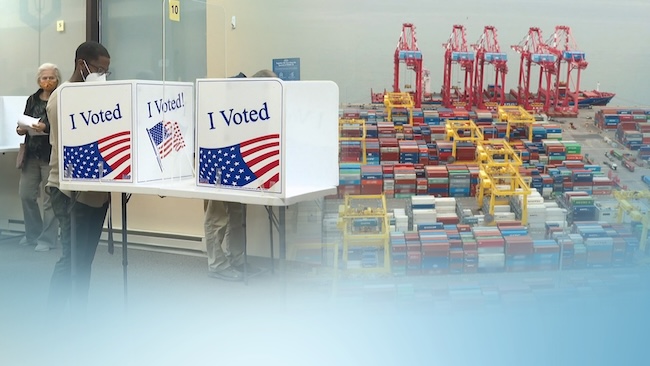
The possibility of a Donald Trump victory in the U.S. presidential election, with his promises of aggressive tariff policies, is raising additional concerns about the recovery of exports in the coming year. (Image courtesy of Yonhap)
SEJONG, Oct. 29 (Korea Bizwire) – South Korea’s exports, long considered the backbone of its economy, are showing signs of weakness, amplifying concerns about the country’s economic outlook.
The possibility of a Donald Trump victory in the U.S. presidential election, with his promises of aggressive tariff policies, is raising additional concerns about the recovery of exports in the coming year. With domestic consumption yet to show clear signs of recovery, the government’s optimistic economic outlook may need revision if exports, which had been performing relatively well, continue to falter.
According to the Korea Customs Service, the daily average export value for October 1-20 increased by just 1% compared to last year, a dramatic decrease from the 18.5% and 18% growth recorded in August and September, respectively.
The total export value for October 1-20 actually decreased by 2.9% year-on-year, due to both the lower daily average export growth and a reduction in working days by 0.5 days. Among the top 10 export items, eight showed negative growth, with only semiconductors and computer-related equipment showing increases.
Exports to the United States decreased by 2.6%, while exports to China increased by 1.2%, though showing continued deceleration. While monthly exports have grown for 12 consecutive months, analysts note that the recovery momentum is gradually weakening.
The warning signs intensified after the release of the third-quarter GDP preliminary figures on October 24. Exports decreased by 0.4% compared to the previous quarter, dragging down the GDP growth rate by nearly 1 percentage point.
The export recovery that began in the second half of last year has notably slowed in just about a year. Experts attribute this to South Korea’s export structure being heavily dependent on semiconductors.

This photo shows containers at a port in South Korea’s southeastern city of Busan on Oct. 14, 2024. (Image courtesy of Yonhap)
The semiconductor and IT sector’s adjustment, combined with weak electric vehicle demand and strikes in the automotive sector, have become decisive factors in weakening exports.
Joo Won, head of economic research at the Hyundai Research Institute, noted, “The IMF has lowered its growth forecasts for both the U.S. and China for next year. When these countries’ growth rates decline, exports will worsen. Additionally, memory semiconductor prices have been declining since September.”
The government views the third-quarter export decline as temporary, maintaining that the overall trend remains positive when considering the base effects from previous high growth rates. However, even within government circles, there is consensus about growing uncertainties in exports.
The prospect of Trump’s return to power adds another layer of uncertainty. Trump has repeatedly declared his intention to establish a “tariff state” and implement strong protectionist measures if elected. During a campaign rally in Mosinee, Wisconsin last month, he claimed that U.S. allies have treated the country “more unfairly than our so-called enemies.”
South Korea’s trade surplus with the U.S. reached a record high of $44.4 billion last year, and for January-September this year, it has already reached $39.9 billion, potentially setting a new record.
The Korea Institute for Industrial Economics & Trade warns that if Trump returns to power, pressure to reduce this trade surplus could intensify significantly.
Furthermore, the anticipated deterioration in U.S.-China relations under a Trump presidency could adversely affect South Korean exports, given the country’s role in supplying intermediate goods to China.
With domestic demand still sluggish – private consumption grew by just 0.5% while construction investment fell by 2.8% in the third quarter – any weakness in exports could significantly impact South Korea’s growth momentum.
The Bank of Korea has already hinted at possibly lowering its growth forecast of 2.4% for this year, while the government has maintained a 2.6% projection.
The OECD estimates South Korea’s potential growth rate at 2% for both this year and next, lower than the United States’ 2.1% for the second consecutive year. Some analysts warn that under the worst-case scenario, South Korea’s economic growth could fall below its potential growth rate next year.
M. H. Lee (mhlee@koreabizwire.com)






